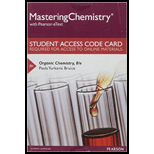
Concept explainers
Interpretation:
To predict which will have higher chemical shift value for the
Concept introduction:
Depending upon the electron density or the concentration of electron around the proton the chemical shift values of the proton varies relative to the reference signal.
The more the shielded proton less will be its chemical shift value and the corresponding signal will be produced at the right-hand side or lower frequency region.
The more the deshielded or less shielded proton more will be its chemical shift value and the corresponding signal will be produced at the left-hand side or higher frequency region.
Proton or set of proton attached near to the more electronegative or electron withdrawing atoms is more deshielded or less shielded and vice versa. The presence of hydrogen bonding in the compound also affects the chemical shift values. The hydrogen bonding causes the decrease in electron density around the proton and causes deshielded due to which the signal for the proton is observed at a higher frequency.
Want to see the full answer?
Check out a sample textbook solution
Chapter 14 Solutions
Organic Chemistry Study Guide and Solutions Manual, Books a la Carte Edition (8th Edition)
- Assign as many resonances as you can to specific carbon atoms in the 13C NMR spectrum of ethyl benzoate.arrow_forwardHow many signals will be found in the 13c NMR of 2 propanol at room temperaturearrow_forwardpredict which set of peaks on the 1H NMR spectrum correspond to the protons on the 2-nitrobenzenesulfonate ring on Probe 1c. Indicate in which chemical shift range these peaks appear and explain why/how you know.arrow_forward
- Which region (A or B) will Ethanol appear in the NMR spectrum and which region (A or B) will Ethanal (2- carbon aldehyde or acetaldehyde ) appear in the NMR spectrum ? Explain your answerarrow_forwardEstimate the 1H NMR chemical shift for the protons onC2 in the following compound.arrow_forwardConsider the proton NMR spectrum of the following ketone.(a) Predict the approximate chemical shift of each type of proton.(b) Predict the number of NMR peaks for each type of proton.(c) Draw a tree to show the splitting predicted for the absorption of the circled protonarrow_forward
- Please help identify all the peaks of the NMR spectrum and the assignments of the compound, 1-(4-bromophenyl)ethanol.arrow_forwardFor the 1 H NMR spectrum of acetyl salicylic acid shown below, assign each signal to the proton to which it corresponds (the COOH proton does not appear on this spectrum).arrow_forwardWhich region (A or B) will Ethane appear in the NMR spectrum and which region (A or B) will Ethanoic acid (2-carbon carboxylic acid or Acetic acid) appear in the NMR spectrum ?arrow_forward
- The1H NMR spectrum of CH3OH recorded on a 500 MHz NMR spectrometer consists of two signals, one due to the CH3 protons at 1715 Hz and one due to the OH proton at 1830 Hz, both measured downfield from TMS. (a) Calculate the chemical shift of each absorption. (b) Do the CH3 protons absorb upfield or downfield from the OH proton?arrow_forwardHow many peaksPredict the number of peaks that you would expect in the proton decoupled 13C spectrum and 1H spectrum of each of the following compoundsarrow_forwardanswer the following questions about the 1-Butanol-,3-methyl-acetate H NMR 1- identify the number of the chemical shift of peaks, signals, and integration of the NMR 2-Justify the identity of the compound using the NMR (how does this NMR represent 1-Butanol-,3-methyl-acetate?)arrow_forward
 Principles of Instrumental AnalysisChemistryISBN:9781305577213Author:Douglas A. Skoog, F. James Holler, Stanley R. CrouchPublisher:Cengage Learning
Principles of Instrumental AnalysisChemistryISBN:9781305577213Author:Douglas A. Skoog, F. James Holler, Stanley R. CrouchPublisher:Cengage Learning
 Macroscale and Microscale Organic ExperimentsChemistryISBN:9781305577190Author:Kenneth L. Williamson, Katherine M. MastersPublisher:Brooks Cole
Macroscale and Microscale Organic ExperimentsChemistryISBN:9781305577190Author:Kenneth L. Williamson, Katherine M. MastersPublisher:Brooks Cole


